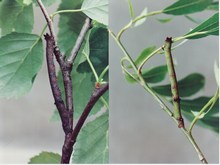
Back تعدد الصفات الظاهرية في الكائنات الحية Arabic Polifenija BS Polifenisme Catalan Polyfenisme Danish Polyphänismus German Polifenismo Spanish Polyfenismi Finnish Polyphénisme French 相変異 (動物) Japanese Полифенизам Macedonian

A polyphenic trait is a trait for which multiple, discrete phenotypes can arise from a single genotype as a result of differing environmental conditions. It is therefore a special case of phenotypic plasticity.
There are several types of polyphenism in animals, from having sex determined by the environment to the castes of honey bees and other social insects. Some polyphenisms are seasonal, as in some butterflies which have different patterns during the year, and some Arctic animals like the snowshoe hare and Arctic fox, which are white in winter. Other animals have predator-induced or resource polyphenisms, allowing them to exploit variations in their environment. Some nematode worms can develop either into adults or into resting dauer larvae according to resource availability.
- ^ Noor, Mohamed A. F; Parnell, Robin S; Grant, Bruce S (2008). "A Reversible Color Polyphenism in American Peppered Moth (Biston betularia cognataria) Caterpillars". PLOS ONE. 3 (9): e3142. Bibcode:2008PLoSO...3.3142N. doi:10.1371/journal.pone.0003142. PMC 2518955. PMID 18769543.
© MMXXIII Rich X Search. We shall prevail. All rights reserved. Rich X Search